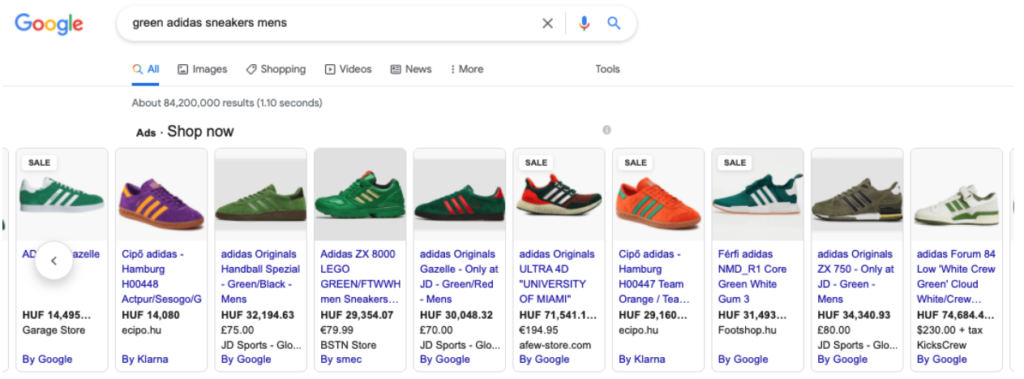A well-optimized feed is the soul and essence of any product campaign. Let it be Google Shopping, Facebook, or Criteo, your feed should be your number one priority to ensure next-level performance.
In the previous article, we discussed how to create profitable shopping campaigns. Let’s dive deeper and understand how you can ensure a top-notch product feed for your campaigns.
How to get started?
First and foremost, to run a Shopping campaign, you will need a product feed filled out as many fields as possible, but containing at least the mandatory product data fields. It can be created by your developer, but certain CMSs generate basic product feeds automatically.
A basic feed with mandatory fields is great to get started, but if you want your campaigns to perform efficiently, then you need to ensure as much data to the campaigns and naturally to the customer as well for your ads to be seen easily.
Take this search result for example. Even if they were not the first listed results, looking for a green pair of shoes, I will most probably not buy a purple or an orange one. This impression can be avoided by filling out the color attribute.

On the other hand, if your title and description are not explanatory enough, your product might fail to gain impressions for valuable search queries.
Product feed optimization methods
- Optimize the original feed: a great foundation is always a must for a successful campaign. Provide as much information as possible in the original feed. Even if this is not necessarily in the best format, that can be altered easily with the following method.
- Feed Optimization Tool (i.e. DataFeedWatch: There are many great tools on the market that help you optimize your feed. These tools indicate the crucial improvement points, help you strengthen your product fields based on created rules. Just to give you a few examples: It appends the brand name to the title, fills out the color field based on the context of the description, or even fills out blank fields with static text if necessary. The best feature of these tools is that once you optimize a feed for a specific channel (for example Google Shopping), you can quickly create new product feeds from these data customized for different channels (such as Facebook, Criteo or Amazon).
- Build a new feed based on the original product feed data: This method is quite similar to a tool, however instead of a software, we create scripts that optimize and refresh your feed.
Which method is better? The mixture of 2 of them (the original feed + a second method). Always provide as much information as possible to work with, then you can optimize and strengthen the feed with one of the last 2 methods.
Must have optimization steps:
- Don’t leave blank values: check your feed, wherever a product attribute is blank, fill that out! The more information you provide, the better.
- Title optimization: This is something we mentioned in the article on shopping campaigns as well, but I cannot reiterate enough the importance of a well optimized product title. This is one of the first elements the user will see in the search results, and what Google uses to understand what you are selling. Include the most important keywords in the title based on industry trends. For example:
Electronics: Brand + Attributes + Product Type + Model #
Apparel: Brand + Gender + Product type + Attributes (color, size, material)
- Product identifier: These attributes are not only mandatory, but also come very handy. Therefore definitely take the time to find either the MPN or GTIN of your products. These identifiers help Google understand what product you are selling exactly, what are the similar/same products from other sellers to compete with. Not to mention that in the Merchant Center you can also compare competitiveness based on product price.
- Google Product Category – When assigning a product category to your items, think of it as allocating your products to the right category in a giant online marketplace. It not only helps Google, but also the customers to find your products easier. That is why it is essential to take the time and pick the narrowest category possible for each of your products.
- Sales price – It might be a no brainer for some, but it is missing many cases. Show off your promotions to users. Make sure they see that the lower price is only temporary.
- Do not forget about optional fields:
- Age group, Color, gender, material, size – these attributes all provide useful information that improves your campaign performance.
- Product detail: this is a jolly joker. If you want to include important data that does not have a standard attribute to use, this is for you. You can include anything that can come in handy, such as energy efficiency, capacity, ingredients, taste, etc.
- Custom labels: this is my personal favorite, that you can use for campaign optimization or reporting purposes. Just to give you a few examples:
- Exclude products above a certain price
- Highlight best selling products
- Stock sweeping
Product feed optimization is not a one-time thing, but a continuous process. Make sure to keep an eye on your feed, check how your campaigns perform and improve your feed wherever necessary.
Do you need help with product feed optimization for any channel?
Drop us a message at hello@mitoperformance.hu
Mito is a full-service agency with a passion for clever things. The Performance division is specialised in improving digital performance and increasing sales with performance media, SEO, CRO and analytics solutions. We are proud to have companies like Decathlon, Wizz Air, Cetelem Bank, Office Shoes and Tungsram among our strategic partners.
The author(s)
Dóra Gergely-Gyuris
E-commerce PPC Expert


